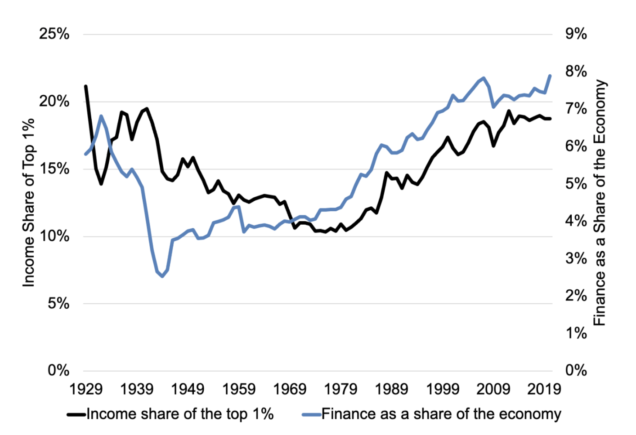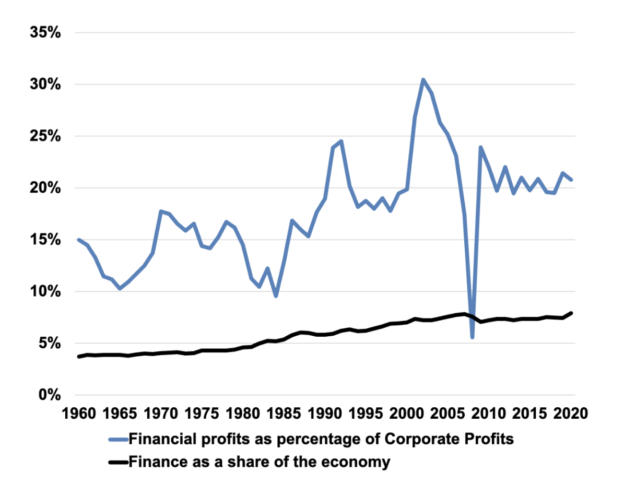Mad Money: The Financialization and Rising Inequality of the US Economy

By Pratistha Joshi Rajkarnikar
A recent UN news story blames the excessive speculation in the financial markets for impeding basic human rights. The 2022 World Development Report highlights the need to address fragilities within the financial sector for a sustainable recovery from the pandemic, and several studies have linked the rise of finance to lower productivity, slower growth, higher unemployment and increasing inequality.
The association between inequality and financialization has become particularly apparent in recent decades. In the US, for example, growth in inequality has occurred concurrently with the expansion of the financial sector, as shown in Figure 1 below. How does financialization influence inequality outcomes? And how can the adverse impacts of financialization be mediated across the economy?
Figure 1: Finance and Inequality, 1929 – 2019

The Rise of Finance
The financial sector is a primary driver of a nation’s economy. It supports activities in the real sector, which concerns with the production of goods and services in the economy, by intermediating funds to allocate capital where it is needed. It also facilitates investments in various kinds of financial assets, such as stocks, bonds, currencies and mutual funds. But the rise of finance is often viewed with skepticism and unease as historical events, such as the Great Depression and the 2008 crisis, reveal that upswings in financial sector often make economies vulnerable to crisis and wreak havoc on the real sector.
Over the last few decades, the financial sector in the US has been taking up a larger share of gross domestic product (GDP) and financial profits as a share of the total corporate profits have been increasing, as seen in Figure 2 below. This trend of the growing size and importance of the financial sector in the operation of the overall economy is referred to as the financialization of the economy.
Figure 2: Financialization of the US Economy, 1960-2020

The financialization of the US economy has been facilitated by the deregulation of the financial sector since the 1970s, which has enabled financial firms to increasingly engage in high-risk activities. Finance has moved away from its traditional role of lending for consumption and investment on productive activities and directed more funds towards lending against existing financial assets, meaning, funds are increasingly not going towards building factories or hiring workers, but towards investing in stocks, bonds and mutual funds to reap short-term profits from rising asset prices.
The process is self-perpetuating—as more funds are directed towards financial assets, the price of those assets increases, generating potential for profits and encouraging further investment in financial assets. This is what has happened over the last few decades, making financial investments an attractive strategy for both financial and non-financial firms. However, because the rise in asset prices is partly driven by speculative demand, and not an increase in the intrinsic value of these assets, economists have warned about an impending economic crisis from the bursting of this asset bubble, which could have damaging consequences for the broader economy.
Another key impact of the financialization of the US economy has been the rising debt for American families. Over the last few decades, households have become increasingly reliant on loans from the financial sector to meet their expenses, due to the stagnation of real wages in combination with decades of low interest rates and easy borrowing conditions. Average debt held by US households has increased from about 60 percent of disposable income in 1980 to over 130 percent in 2007 and declined slightly since then to about 101 percent as of 2020. This high debt dependence raises serious concerns about long-term financial sustainability for Americans.
Finance and Growing Inequality
Financialization has exacerbated inequality in the US in several ways. First, as economies become more financialized, capital income (i.e., the income from owning capital assets, such as profits, rents and interests) grows faster than labor income or wages. Because a greater share of capital income goes to people in higher income brackets, financialization contributes to rising inequality.
In the US, for example, 89 percent of stocks is owned by the richest 10 percent of the population, so gains in stock prices mostly go to the rich. This was particularly evident in the 2020 pandemic, where the surging stock market amid a public health crisis widened the gap between a few super-rich people and the rest. In the first few months of the pandemic, the richest 1 percent of the population increased their wealth by $5.6 trillion, with about 70 percent of this gain coming from stock market, while the bottom 90 percent only gained $1.2 trillion.
Labor income, which is the key source of income for over 90 percent of the population, on the other hand, has barely grown over the last few decades, partly because of the financialization of the non-financial sector. For example, General Electric, a company that is mostly associated with manufacturing, earned 43 percent of its profits from financial activities in 2014. Today, American companies in every sector earn five times more revenue from financial activities, such as investing, hedging and offering financial services, than they did before 1980. This has severely limited the ability of workers to bargain for higher wages, discouraged investment in the real sector and sapped entrepreneurial talent. In fact, about half of the decline in the labor share of national income since 1970 has been attributed to financialization.
Financialization is also associated with the rise of shareholder capitalism—the idea that corporations should ‘maximize shareholder value’ and focus on increasing profits, while issues of welfare of consumers and workers, health of communities and environment are best left to policymakers. This has encouraged restructuring firms to benefit managers and shareholders at the expense of workers and their communities.
Firms have also increasingly relied on increasing shareholder value through stock buybacks (i.e., buying their own stocks). This strategy is attractive for executives, as an increasing share of their pay has been tied to stock valuation, but this creates no productive value in the economy and only encourages speculative behavior that introduces instability in the financial markets. The buybacks became especially notable in 2017, when it was observed that tax cuts received by firms largely funded stock buybacks rather than productive investments that would have supported workers.
Another factor contributing to rising inequality is the difference in wage growth between the financial sector and the rest of the economy. Research from Economic Policy Institute shows that the ratio of overall pay of financial-sector workers relative to workers in other sectors has risen from about 1.1 percent between 1952-1982 to over 1.8 percent by 2007. Average compensation in the financial sector is over $100,000 today compared to just $20,000 in 1980. The acceleration of wages in the financial sector could also deprive other sectors from skilled productive workers and limit the growth potential of the economy.
Policies for Building a Stable and Sustainable Financial Sector
As the financial sector has grown, it has become more politically influential and able to push reforms and regulatory changes that encourage predatory lending, higher risk-taking and the erosion of worker protections. How can the US ensure that the financial sector is not extractive but rather focuses on building a better future for society at large? Some key suggestions include:
- Promoting regional and community financial institutions, credit unions and other smaller financial institutions that focus on supporting local businesses and homebuyers.
- Encouraging cooperative-based organizations, such as worker-owned companies and community development corporations that tend to be locally oriented and motivated to invest in the long-term viability of the company and well-being of workers.
- Instituting a small tax on financial transactions to discourage short-term speculation in the financial markets.
- Restricting companies from stock buybacks, rewarding them for investing in their employees, linking executive pay to productive performance rather than share prices and adding worker representatives on corporate boards.
- Discouraging predatory and risk-taking behavior among financial firms by giving the Federal Reserve greater oversight of the financial health of borrowing institutions and instituting minimum requirements on holding capital reserves for large financial institutions so they are prepared to cover the risks associated with the financial instruments they create.
- Strengthening bargaining power of workers by encouraging unions and making institutional reforms to reduce the inequality-increasing effects of financialization.
- Reforming political process to weaken the influence of financial corporations and wealthy elites on policymaking.
Both growing inequality and increasing financialization hurt the productive capacity of the economy. Building a stable and sustainable economic system will require reforming the financial system to benefit society.
*
Never miss an update: Sign up to receive the Economics in Context Initiative newsletter.
